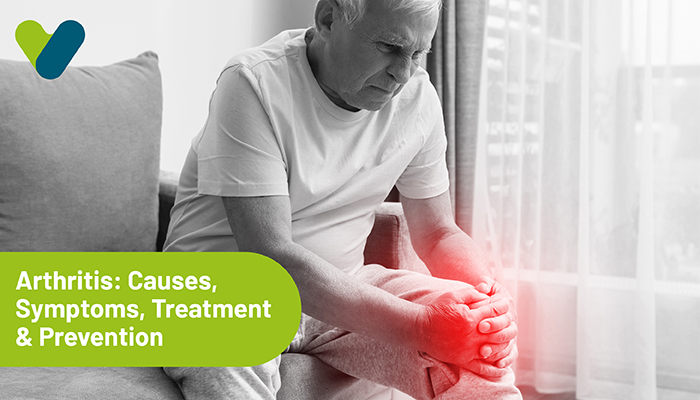Arthritis is a physical condition that primarily affects the joints. It is also referred to as joint inflammation. The word arthritis is an umbrella term that involves more than 100 types of diseases that affect the connective tissues in and around the joints. It typically occurs as you age, and arthritis patients generally experience pain in body parts like the knees, hips, feet, lower back, hands, and feet. The main symptoms of this ailment include swelling, stiffness, and compromised range of motion in joints. In some cases, the symptoms may worsen and cause deformity in joints. Although the disease occurs in people of all ages, it is most prevalent in older people.
Types of arthritis
Arthritis can be mainly categorised into the following conditions:
- Osteoarthritis: Mainly occurring in the spine, hands, hips, and knees, osteoarthritis occurs due to the wear and tear of joint muscles. It develops when the joint cartilage breaks down. Additionally, the condition involves weakened joints and deterioration or inflammation in the joint lining. Joint pain, stiffness, and clicking noises are some signs of osteoarthritis. Regular exercise, maintaining a healthy weight, and pain relievers are ways to manage the symptoms arising from this type of arthritis. If the condition is severe, patients may need to undergo surgery to rectify or replace the affected area.
- Infectious Arthritis: When a bacterial, fungal, or viral infection travels from another body part to the joints, it triggers infectious arthritis. Infections like salmonellosis, gonorrhoea, and hepatitis mainly impact the joints. A doctor detects them by testing the fluid from the affected joint to treat the condition. The treatment primarily involves the use of antibiotics and antifungal medications. In case a patient's condition becomes chronic, doctors may remove the joint fluid in the infected area to reduce inflammation and prevent damage.
- Gout: Also known as metabolic arthritis, gout is a type of arthritis caused due to crystallisation of uric acid in joints. When the body fails to get rid of the uric acid after breaking down the purines in human cells, it accumulates in joints. As a result, you experience sudden and severe pain attacks, especially in the big toe. Besides uric acid crystallisation, disruption in the microbiome, damage from osteoarthritis, and white blood cells in the joint fluid also cause gout. Doctors may recommend a low-purine diet and medications to treat this condition. Rheumatoid Arthritis: Rheumatoid arthritis is an autoimmune disorder which occurs when the body's immune system mistakenly attacks its tissues. Such dysfunctional activity results in inflammation in joints and other organs like the eyes, skin, and heart. Due to swelling in the synovial membrane of the joints, this type of arthritis is also known as inflammatory arthritis. Over a long period, the joint inflammation may cause bone erosion and joint deformity. Doctors treat the condition with anti-rheumatic drugs and biological therapies.
- Ankylosing Spondylitis: Ankylosing spondylitis is a form of spondylarthritis that develops due to the fusing of the bones in the spine. The fusing reduces the flexibility of the spine and causes a hunched posture. The main symptoms of such fusing include lower back pain, stiff spine, and hip pain. One of the best ways to manage discomfort is to exercise and maintain flexibility. Pain relievers are also useful in reducing the progression of swelling in the affected body parts. Juvenile Idiopathic Arthritis: Arthritis disease in children below 16 years is known as juvenile idiopathic arthritis. It results in stiffness, pain, or swelling in joints of any body part that lasts for months or even years. When the condition worsens, children encounter growth problems, joint damage, and eye inflammation. There is no cure for this autoimmune disease which targets the synovium. The treatment approach involves controlling pain and inflammation with medications and exercise.
Symptoms of Arthritis
Some known arthritis symptoms that progress from mild to severe include the following:- Joint pain
- Tenderness
- Stiffness
- Limited range of mobility
- Redness and warmth in tendons and ligaments
- Muscle weakness
- Swelling around the joints
What Causes Arthritis?
The causes vary depending on the type of arthritis. Some of the leading causes include:- Obesity that strains the joint muscles
- Activities involving the repetitive motion of a particular joint
- Sports injuries
- Genetics
- Dysfunctional immune system
- Ageing leading to worn-out joints
- Bacterial, viral, or fungal infections triggering joint inflammation
- Muscle weakness.
Diagnosis of Arthritis
A physician conducts a physical examination and studies your symptoms to diagnose arthritis. The physical exam includes assessing your joint mobility, checking for tenderness or swelling, and evaluating your overall health condition. Imaging tests like X-rays and MRI are also used to detect complications like cartilage breakdown around your joints, muscle or ligament injuries, soft tissue inflammation, etc. Other diagnostic tests include blood, urine, and joint fluid testing to detect uric and inflammatory proteins. Arthritis treatment mainly includes controlling the pain and inflammation and preventing the condition from progressing. Some of the methods used in the treatment course include the following:Medications: Doctors prescribe nonsteroidal anti-inflammatory drugs (NSAIDs) and painkillers for relieving arthritis symptoms. They also advise medications like biologics that target the inflammatory response of the immune system. Disease-modifying antirheumatic drugs (DMARDs) and counterirritants are some other medications that help manage arthritis. Physical Therapy: Modifying physical activity helps in strengthening joint muscles and improves the range of motion. Hence, doctors recommend physical therapy to reduce arthritis pain and inflammation. They may also use equipment like resistance bands, foam rollers, aerobic exercising machines, etc., to aid the process. In case of severe symptoms, doctors recommend braces to protect the joints from further damage. Lifestyle Changes: Unhealthy lifestyle habits are among the most prominent causes of arthritis disease. Therefore, making healthy changes in your daily activities helps in treating the condition. Such modifications involve maintaining a healthy body weight, planning a balanced diet, avoiding alcohol, and controlling stress. Doctors may also recommend avoiding engagement in adventurous sports as they increase the risk of joint injuries. Surgery: If arthritis symptoms become unmanageable with conservative treatments, joint repair surgery is an effective solution. It helps smoothen and realign joint surfaces to reduce pain and improve functionality. If the joints are damaged, you may need to undergo joint replacement surgery. Joint fusion is another surgical method used for smaller joints like the ones in the wrists, ankles, and fingers.
Complications Resulting from Arthritis
When left untreated, arthritis leads to the following complications:- Reduced mobility in joints that interfere with your daily activities.
- Decreased movements causing weight gain.
- Inflammation spreading to other body parts like the eyes, blood vessels, and lungs.
- Muscle weakness, which increases the risk of falls without adequate support.
- Ongoing pain and discomfort lasting for longer period, which may also impact mental health.
- Increased weight due to limited movement, which further increases the risk of metabolic disorders like high blood pressure, high cholesterol, type 2 diabetes, heart diseases, etc.


